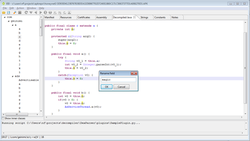History
JEB was the first Dalvik decompiler to provide interactive output, as reverse-engineers may examine cross-references, insert comments, or rename items, such as classes and methods. Whenever possible, the correspondence between the bytecode and the decompiled Java code is accessible to the user. Although JEB is branded as a decompiler, it also provides a full APK view (manifest, resources, certificates, etc.). An API allows users to customize or automate actions through scripts and plugins, in Python and Java.
JEB 2.2 introduced Android debugging modules for Dalvik and native (Intel, ARM, MIPS) code. Users can "seamlessly debug Dalvik bytecode and native machine code, for all apps [...] including those that do not explicitly allow debugging". [3]
JEB 2.3 introduced native code decompilers. The first decompiler that shipped with JEB was a MIPS 32-bit interactive decompiler.
JEB 3 shipped with additional decompilers, including Intel x86, Intel x86-64, WebAssembly (wasm), Ethereum (evm), Diem blockchain (diemvm).
JEB 4 was released in 2021. A RISC-V decompiler was added to JEB 4.5. A S7 PLC block decompiler was added to JEB 4.16.
JEB 5 was released in 2023. A SASS decompiler for Nvidia GPU code targeting Volta+/sm_70+ architectures was added to JEB 5.31.
This page is based on this
Wikipedia article Text is available under the
CC BY-SA 4.0 license; additional terms may apply.
Images, videos and audio are available under their respective licenses.

